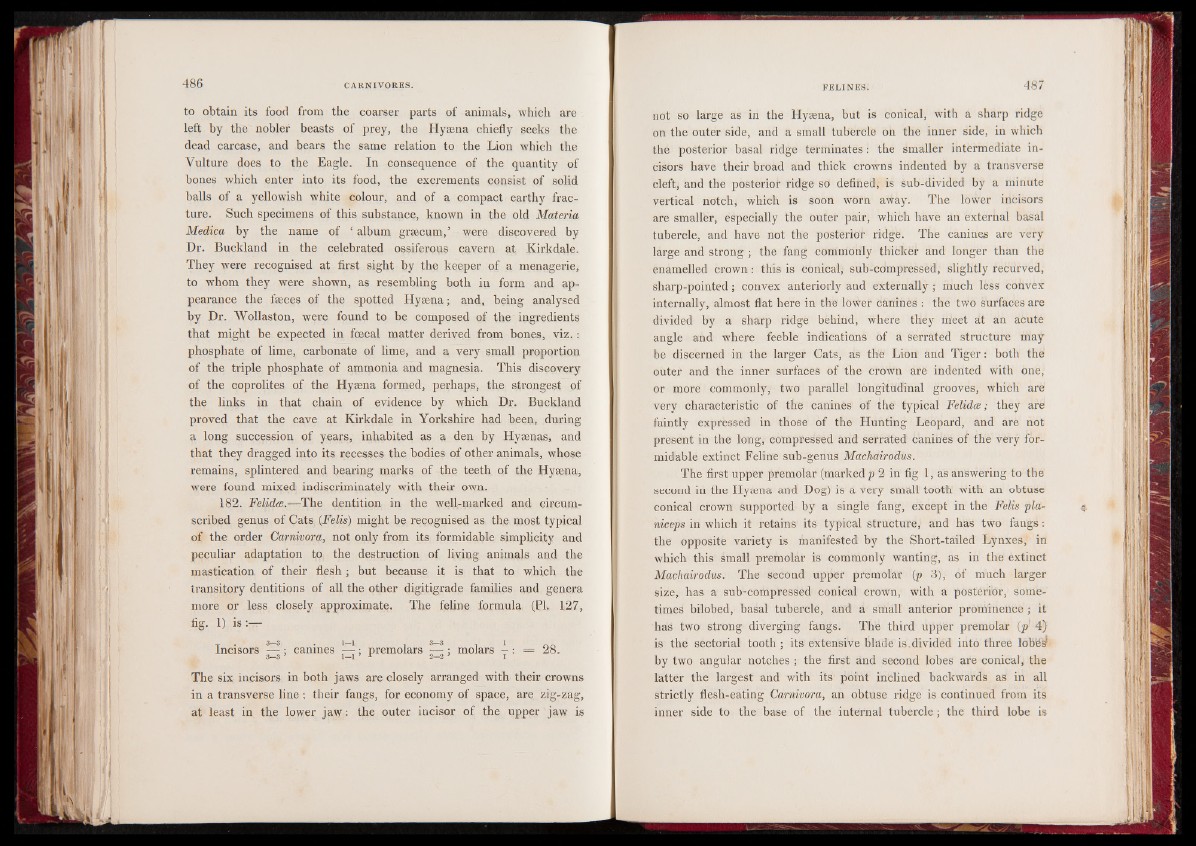
to obtain its food from the coarser parts of animals, which are
left by the nobler beasts of prey, the Hyaena chiefly seeks the
dead carcase, and bears the same relation to the Lion which the
Vulture does to the Eagle. In consequence of the quantity of
bones which enter into its food, the excrements consist of solid
balls of a yellowish white colour, and of a compact earthy fracture.
Such specimens of this substance, known in the old Materia
Medica by the name of ‘ album graecum,’ were discovered by
Dr. Buckland in the celebrated ossiferous cavern at Kirkdale.
They were recognised at first sight by the keeper of a menagerie,
to whom they were shown, as resembling both in form and appearance
the faeces of the spotted Hyaena; and, being analysed
by Dr. Wollaston, were found to be composed of the ingredients
that might be expected in fcecal matter derived from bones, viz.:
phosphate of lime, carbonate of lime, and a very small proportion
of the triple phosphate of ammonia and magnesia. This discovery
of the coprolites of the Hyaena formed, perhaps, the strongest of
the links in that chain of evidence by which Dr. Buckland
proved that the cave at Kirkdale in Yorkshire had been, during
a long succession of years, inhabited as a den by Hyaenas, and
that they dragged into its recesses the bodies of other animals, whose
remains, splintered and bearing marks of the teeth of the Hyaena,
were found mixed indiscriminately with their own.
182. Felidm.—The dentition in the well-marked and circumscribed
genus of Cats (Felis) might be recognised as the most typical
of the order Carnivora, not only from its formidable simplicity and
peculiar adaptation to the destruction of living animals and the
mastication of their flesh; but because it is that to which the
transitory dentitions of all the other digitigrade families and genera
more or less closely approximate. The feline formula (PI. 127,
fig. 1) is
Incisors — ; canines — ; premolars — ; molars —: = 28. 3—3 ’ 1—i ’ v 2—2 ’ I ,
The six incisors in both jaws are closely arranged with their crowns
in a transverse line ; their fangs, for economy of space, are zig-zag,
at least in the lower jaw: the outer incisor of the upper jaw is
not so large as in the Hyaena, but is conical, with a sharp ridge
on the outer side, and a small tubercle on the inner side, in which
the posterior basal ridge terminates: the smaller intermediate incisors
have their broad and thick crowns indented by a transverse
cleftj and the posterior ridge so defined, iss sub-divided by a minute
vertical notch, which is soon worn aitfay. The lower incisors
are smaller, especially the outer pair, which have an external basal
tubercle, and have not the posterior ridge. The canines are very
large and strong ; the fang commonly thicket and longer than the
enamelled crown: this is Conical, sub-cdmpressed, slightly recurved,
sharp-pointed; convex anteriorly and externally; much less convex
internally, almost flat here in the lovter canines : the two surfaces are
divided by a sharp ridge behind, where they meet at an acute
angle and where feeble indications of a serrated structure may
be discerned in the larger Cats, as the Lion and Tiger: both the
outer and the inner surfaces of the crown are indented with one,
or more commonly, two parallel longitudinal grooves, which are
very characteristic of the canines of the typical' Felidae; they are
faintly expressed in those of the Hunting Leopard, and are not
present in the long, compressed and serrated canines of the very formidable
extinct Feline sub-genus Machairodus.
The first upper premolar (marked p 2 in fig 1, as answering to the
second in the Hyaena and Dog) is a very small tooth with an obtuse
conical crown supported by a single fang, except in the Felis pla-
niceps in which it retains its typical structure, and has two fangs:
the opposite variety is manifested by the Short-tailed Lynxes, in
which this small premolar is commonly wanting, as in the extinct
Machairodus. The second upper premolar (p 3), of much larger
size, has a sub-compressed conical crown, with a postOrior, sometimes
bilobed, basal tubercle, and a small anterior prominence ; it
has two strong diverging fangs. The third upper premolar (p' 4)
is the sectorial tooth ; its extensive blade is.divided into three lobbs1
by two angular notches ; the first and second lobes are conical, the
latter the largest and with its point inclined backwards as in all
strictly flesh-eating Carnivora, an obtuse ridge is continued from its
inner side to the base of the internal tubercle; the third lobe is